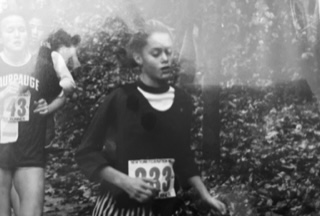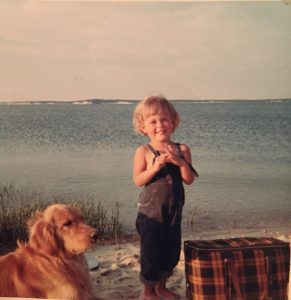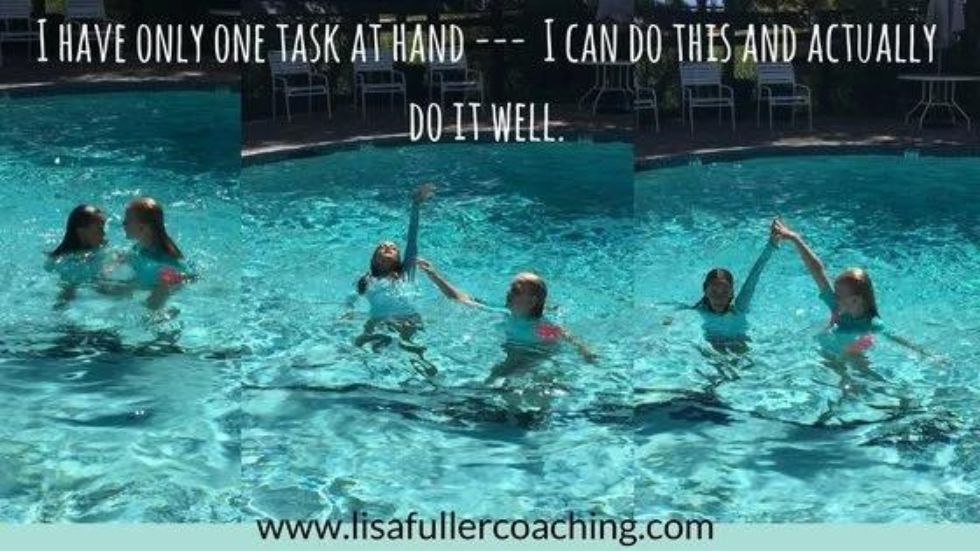by Lisa Fuller | Sep 7, 2023 | Communication, Conflict, Connection & Love, Encouragement, General, Parenting, Self-care, Setting Limits, teenager
 I was competing in my first cross country race, a freshman in high school, when I hit the notorious ‘wall’ going up aptly named Cemetery Hill in Van Cortlandt Park in the Bronx. My legs felt like lead stumps, my breath was short and effortful, and utterly defeated I decided to walk. Then I heard a voice, it was my Coach Mitch, yelling in his Queens accent, Come on Fuller, you can do this!!! I didn’t even know he was there, yet somehow he appeared, clipboard shoved in his armpit so he could clap his hands and wave me up the hill. As I trudged past him, I used the little energy I had to swear at him.
I was competing in my first cross country race, a freshman in high school, when I hit the notorious ‘wall’ going up aptly named Cemetery Hill in Van Cortlandt Park in the Bronx. My legs felt like lead stumps, my breath was short and effortful, and utterly defeated I decided to walk. Then I heard a voice, it was my Coach Mitch, yelling in his Queens accent, Come on Fuller, you can do this!!! I didn’t even know he was there, yet somehow he appeared, clipboard shoved in his armpit so he could clap his hands and wave me up the hill. As I trudged past him, I used the little energy I had to swear at him.
I had to keep going
At the time I didn’t understand it but looking back now it’s clear I was furious at Mitch because I wanted to give up and he wouldn’t let me. His words meant someone had faith in me and was expecting me to finish, so I had to keep going.
We are both the runner in this story AND the coach
As parents, we know that standing by our children during their darkest hours requires a special kind of endurance. We are both the runner in this story AND the coach. We have to endure the pain and take the brunt of our children’s stress, anxiety and even anger at the challenges they face.
Do you remember that feeling of intense love and simultaneous dread when you first became a parent? For me it sounded like this, “from here on out, I will, without question, jump in front of a bus for this human.” My children would forever be my priority.
But it wasn’t until son #2 was in high school and became addicted to vaping, then drugs, that I realized the depth of inner strength I’d need to endure this level of challenge for my child.
Parenting calls upon the limits of human endurance
If you’ve ever loved a child suffering with addiction (or mental health issues, learning differences, social challenges or any of the other tough situations that young people face), you know how hard and painful it is to let go while also being present and not giving up. Parenting calls upon the limits of human endurance.*
FIX IT!
As a mother, my first instinct was to fix the problem. I fed him nutritious and delicious meals. I monitored who he hung out with, where he went. I tried, through lengthy discussion, to talk him out of it. And we even went to hot yoga together twice a week at 5:30am (confusing I know but it was part of his effort to convince me that he didn’t have a problem). But nothing fixed it or got him to stop using drugs. Nothing fixed the tension in our home, the silence, the anger and sadness.
Let go….
Finally, with resignation and relief, I let go and focused on what I could control: myself. I knew the only thing I could do was to continue showing up for him. Continuing to show up for someone you’re sometimes afraid of and other times furious at isn’t simple. Equally, if not more difficult was to continuously muster the courage I’d need to have faith that he would get through it, that he would make it up that hill alive.
Most of the time I felt like a failure and also a person who was doing her best.
During these three years my father died, my grandmother died, my dog died and I was diagnosed with skin cancer.
As a parent we endure what our children go through while juggling the complexities of our own life.
During these three years, I was in disbelief, not that this was happening in our family, but just at how extraordinarily painful life can be.
I questioned if I could keep going through my grief and fear, but I knew that giving up was not an option. It felt like that bus I’d imagined 20 years ago was heading directly for me.
With some combination of good fortune and persistence, my son and I survived, which is a story for another time. Everyday I’m grateful and everyday I know how lucky we are because there are so many families who continue to suffer or don’t make it.
Today he’s working as a counselor with young people facing addiction while attending college. He tells me that what made the difference for him was knowing he had a family that loved him and didn’t give up on him, even when he gave up on himself.
You can read my specific strategies for supporting a child in the throes of addiction below.
If you’re facing a hard situation as a parent I’m here to remind you:
- You’re not alone and that the isolation that parents feel during such a struggle adds immeasurably to the pain… so even though it can feel impossible, I encourage you to reach out for support.
- While you feel like you’re forging your way up your own Cemetery Hill, you have the power to tap into the special kind of endurance despite the sadness, anger or fear you may be experiencing, you can do this. You can hang in there when it hurts and when you mess up and say the wrong thing. Your child will know you tried your best even in the worst of times.
You can do this!!!
Endurance of mind, heart and body for loving an addicted child:
- Establish firm boundaries around safety: I did not leave his younger sister alone with him, nor did I let him drive the car.
- Don’t be afraid to enlist help: I met repeatedly with the vice principal to discuss strategies to make drug use at school more difficult, and reached out to teachers and coaches for support.
- Allow for natural consequences: I did not call the school to excuse his tardiness, absenses, missed work, or neglect for sports practice or competitions.
- Take care of yourself: I made imperfect efforts towards attending weekly (sometimes daily) Al-Anon meetings, reaching out to friends for support, writing it down, exercising, eating healthy food and trying to get enough sleep (this was particularly challenging).
- Cultivate self-compassion: this level two in self-care is a key to how well we treat ourselves and others. Kristen Neff has exercises to help cultivate true self-compassion and one of those is writing.
- Strive for consistency: I maintained predictable meal times, regular communication, and continued to literally tuck him in at bedtime each evening, despite the pain of facing his condition.
- Be present for the recovery journey: I researched school and treatment options, accompanied him to programs, picked him up when he failed, found other options, and kept walking the road with him towards recovery.
- Share your struggle with others: I didn’t keep his drug problem a secret or let it become a cause for shame for him or myself. I reminded myself that drug addiction is an all too common issue for families and I could lean on others for support.
To learn more about how I might be able to support you, schedule a time to meet.
Join my 7-week Parenting Series (via Zoom) beginning September 28th!
This post was inspired by a quote by George Yeoman Pocock that I first read years ago as it was the epigraph to The Boys in the Boat by Daniel James Brown. I was teaching parenting classes at that time and the words jumped off the page. His insights into the special kind of endurance needed for rowing described perfectly the predicament we parents find ourselves in.
Rowing is perhaps the toughest of sports. Once the race starts, there are no time-outs, no substitutions. It calls upon the limits of human endurance. The coach must therefore impart the secrets of the special kind of endurance that comes from mind, heart, and body.
by Lisa Fuller | Feb 22, 2023 | Communication, Connection & Love, Encouragement, General
By Kelly Bartlett
I use the word “empathy” a lot when I’m talking about parenting. Sometimes I forget it might not be entirely clear exactly what is meant by using empathy when communicating with children. When you hear or read that children need empathy and that parents can help resolve conflicts and bridge connections with empathy, what do you think? Do you know right away what to do or how to respond?
As Brene Brown so succinctly says, “Empathy is the antidote to shame.” It is what’s needed when a child feels bad, struggles emotionally, or has made a mistake. What children don’tneed in those moments is additional shame tacked on to their mistakes and unpleasant feelings to make them feel worse or unlovable. What children do need is empathy to see them through those moments. Empathy to reinforce your relationship. Empathy to help regulate brain chemistry; to assure a child, “The way you feel is normal. You’re normal.” Empathy to provide validation. “You have a right to feel that way.” Empathy to help a child get on the road to self-acceptance and self-love. “You may have made a mistake, but you are not a mistake.”
Here are five things you can do that will help you respond to a hurting child with empathy:
1. Take your child’s perspective. See the world through his eyes. His problems might seem trivial to you, but try to see them as he does. Broken crayons, lost toys, stuck zippers, or nightly clean-up time mean more to your child in his world than they do to you in yours.
2. Refrain from judgment. Yes, you may disagree with your child. You may think she was “wrong” for what she did, said, or felt during the conflict she had at school that day, but put that aside for now. Your child doesn’t need your judgment, she needs to be able to impart her own judgment. Help her do that by focusing on her feelings regarding what happened.
3. Communicate your understanding of your child’s feelings. This can be a glance, a nod, a knowing look. It’s kindness in the eyes and an “I get it” arm-wrap. It can be words, sure, but above all it’s a message. It’s a message that you understand because you’ve also had similar moments and similar feelings. Let him know you are here as his equal in this moment.
4. Stop before you say BUT. “Yes, you got into an argument with your friend. That happens. He got angry; your feelings were hurt. You’re very upset. BUT, you still should not have hit him…BUT that’s no reason to quit the game…BUT you need to learn how to control your temper.” It’s that last part that needs leaving off–that’s not part of empathy. Empathy is just sitting with the feelings for a bit. That might be really hard! It might feel unfinished. It might feel awkward to stop at, “You were really embarrassed.” and not add on some kind of resolution or suggestion. Don’t go there though…not yet.
5. Instead, try AND. After a period of empathic listening and probably plenty of tears, you can move on.
“…and your friend got hurt.”
“…and now what should we do?”
“…and what if this happens again?”
“…and is there something that will help you in the future?”
“…and is there a way to fix this mistake?”
“…and is there a way I can help you?”
Only after you have helped your child process her feelings through validation and understanding will she be able to move on to problem solving and the “what-to-do-now”s.
When we raise our children with regular expressions of empathy, they will learn through experience just what empathy looks like, sounds like, and feels like, and they will, in turn be able to give it to others.

by Lisa Fuller | Jan 20, 2022 | Communication, Encouragement, Feelings & Emotions, General
As a kid, I often heard: “Don’t be full of yourself.”
I remember my mom sitting on the hamper beside the tub as I took a bath.
Holding out my arm to her I said “Look at my tan!” My parents worshipped the sun.
“Lisa,” she said. “Don’t be so vain.”
“You’re So Vain” was on one of our six 8 track cassettes and I knew every word, would sing along and ponder its meaning, staring out the car window. (The song has a very cool intro.)
Our family had an unspoken mantra: Even if you’re good at something, don’t show it. Make yourself small so no one can cut you down.
Decades later, when I picked my daughter up from pre-school, I asked her teacher, “How’d it go today?”
Our beloved Gay Gay replied,
“It was great! Your daughter is so full of herself!”
She smiled her huge smile and laughed her cackling laugh, like this was news to be celebrated!
Her words and positive energy seared into my brain.
This new interpretation felt like a window opening letting a cool breeze into a hot yoga studio.
“It was great! She is so full of herself!”
Here was my daughter: a self-possessed three year old, full of her interests, her curiosity, her body, her life… full of herself!
This past weekend, driving home from a glorious walk along the San Francisco Bay, I listened to my friend Suzie telling a story and the old expression escaped her lips: “So and so is so full of themselves” and not in a good way.
Remembering Gay Gay and my epiphany that day, I interrupted Suzie, “Wouldn’t it be great if we were all full of ourselves?! Isn’t that what we want because, sh*t, what’s the alternative?”
She squeezed my arm. “You’re right. If we’re empty — void of ourselves — then who or what will fill us? Whatever comes along and these days there’s too much bad stuff to fill us if we don’t fill it with ourselves.”
Here’s the bee in my bonnet for the start of 2022…. Let’s all be full of ourselves and encourage that in the ones we love.
I aspire to be more full of myself this year and invite you to do the same. I don’t know exactly what that will look like, but I’m excited to pay attention and find out.
Please let me know what it looks like for you!


by Lisa Fuller | Jun 15, 2019 | Communication, Encouragement, General, Mutual Respect, Parenting, teenager
When I first heard the report on the radio I thought it was a hoax.
At least 50 people have been charged with participating in alleged conspiracy that involve cheating on college entrance exams, like the SAT and ACT. Some of their children were admitted to elite colleges, including Yale, Stanford, UCLA and the University of Texas, by bribing coaches.
NPR.org
I listened further and quickly realized it was no joke. I felt stunned then disgusted and outraged. Then I noticed I also felt surprised. These were quite strong feelings to have over something that didn’t involve me or anyone I knew personally. My heart ached because of the obvious social injustice that permeates every aspect of our society but there was more.
I realized that the story drew me in because — if I’m being honest with myself — I could genuinely relate to the motivation of those parents.
While for the most part I’ve resisted the urge to fix everything for my children the way these parents so blatantly did, I have, on several occasions, had a panicky sensation that I’ve got to get ahead of this! One that’s accompanied by an intense fear that my child will feel badly … or even (gasp!) fail at something important.
Do these internal thoughts sound familiar?
- If she finds out she’s not invited, she’ll be crushed by the social rejection.
- I feel so sad for him that he wasn’t chosen for the team.
- This learning disability will ruin his self esteem and likely his life.
- She won’t be able to get over the experience of a serious illness or injury.
- He’ll become depressed if I limit screen time or don’t get him a smartphone.
- Why doesn’t she have more friends? What’s wrong with her?
These parental fears are more common than you think. The impulse to smooth it over and FIX IT for our kids is the norm these days.
What the Varsity Blues example makes so clear is that the short term fix leads to much bigger long term problems.
For our “little” issues its true, too. I recently heard a story of a mom who was distraught because her 13 yo daughter wasn’t being included in the activities of the popular girl clique. What that mom didn’t know is that her distress likely increased — and even created additional suffering for her daughter.
And, we’re mistaken if we think our unspoken fears won’t impact our children. Kids are energetic sponges. They feel our doubt and it colors their confidence and resilience.
What we need to remember is that when we excessively worry about our child’s life and sometimes even move to “fix it,” we’re telling them:
- You’re not enough just as you are,
- There’s a narrow range of what’s acceptable,
- What matters most is what others think,
- You’re incapable of managing your own live.
Believing in your child’s unique capabilities, embracing who they are, just as they are, is by far the most important stance you can take as a parent.
I’m not suggesting that you ignore or deny their struggles, but we can choose faith over fear as our guide and take a grounded position with them. In Positive Discipline we use the metaphor of a tree, strong, balanced and flexible. When we bring these qualities to parenting, our children they have a sure place to rest.
What inspired me to write this post was what my 12 year old daughter shared after she read an article about the admissions scandal.
“Mom, you know what the worst part is? Let’s say I got into Harvard and then found out that you had paid them to get me in… the worst part would be knowing that you didn’t believe in me.”
my 12 yo daughter
She’s right.
Believing in your child is a tremendous gift to them.
In Deborah McNamara’s article, Resilience: Embracing the Emotional Journey, she writes,
It is a parent’s belief in a child that helps them feel there is a way out of it all.
Deborah McNamara
Here are 4 specific ways you can show your child that you have faith in who they are:
- Give children of all ages opportunities to pitch in and be responsible. This often takes letting go of your expectations of how the task is completed. (The dishes may not be as sparkly as you make them!) Let them know their contribution makes a difference. More ideas.
- Pay attention to your child and get to know and appreciate them for all they are, not just the easy to love parts. Looking back now, I see I could have spent more time learning about and even playing video games with my son. More ideas….
- Love and connect with your child each day. While this sounds obvious, time gets away from us and it helps to be reminded to intentionally connecting. More and even more ideas….
- Learn to tolerate and even embrace feelings, both yours and your child’s. When hard stuff happens, resist the “fix and rescue” mode and instead practice letting go. In doing so, your child will have an opportunity to genuinely feel their disappointment, anger, sadness… you name it. When appropriate, help your child name their feelings. Research shows that when we label our emotions, we’re better able to integrate them.
My friend shared a mantra she uses to help her remember, in the most challenging moments, that her child’s path is just that, her child’s path:
Love the child you have, her path may not be the one you imagined but it’s right for her.
The bottom line is, your child is going to be ok.
That doesn’t mean it’s always going to be fun or easy, but at a deeper level, she will be just fine, whether she’s reading by first grade or not, whether she goes to the prom or not, whether she attends college or not. She’ll always have a loving family and that’s the only part you can control.
After writing this post I listened to a discussion on the radio program, Fresh Air, addressing this very topic. I was struck by the guest’s advice for parents supporting their older teens:
Your child is the expert on himself or herself. We are 20th-century parents giving advice to 21st-century kids. They’ve inherited a brave new world that we never lived in.
Dr. B. Janet Hibbs
I would love to hear your thoughts on this topic.
How do you show your child you believe in him/her? How do you keep perspective? What’s hard? Know that you comments in the section below will support someone who shares your concerns and questions.

by Lisa Fuller | Sep 14, 2017 | Communication, Encouragement, General, Parenting
Remember that day last summer when I took the girls to the pool and I decided to get out of the middle of the parenting road (because heck it’s dangerous standing there!)?
Here’s the scene: I’ve got two 9 year old girls, my daughter Sonja and her friend Gracie. These girls are avid swimmers, eager to get to the pool to play. I fantasize that our trip will include my making serious headway with my summer reading (even tho it’s September), while they amuse themselves.
As it is with parenting, my expectation of time for myself proves a pipe dream as they repeatedly ask me to watch their antics in the water.
I decide to go all in and be present with the girls. I see them with their faces all lit up and full of life because they can tell — I’m all in.
What does being present with them look like?
Their request for attention begins simply.
For the first ten minutes its,
“Mom, tell us who has the biggest splash when we jump in!”
This is easy.
For the next five minutes,
“Mom, now who’s got the smallest splash?”
Next the requests get more complicated.
“We’re going to each make up a dance and you tell us which one is better. We won’t care which one you choose… PLEEEEEEEEASE.”
What kind of attention do I give the girls?
These are the two choices I imagine:
- The fluffernutter with jelly beans sandwich! Equalize the good stuff – like an overdose on sweets. I’ll go back and forth stating whose performance is best.
Wonderful, beautiful. Oh such great moves. I’ll continue with loads of oooohing and Ahhhing. Wow’s coming flying out of my mouth and a resounding you girls are amazing!
Hyperboles abound aimed at both girls, alternating names. They’ll each feel the rush of being the BEST!
- I take a moment to process this request and then say to the girls,
No, that kind of judging is what we call ‘subjective’ — which means just one person’s opinion — and that’s going to be too hard for me.
“Please mom, I promise we won’t care which one you pick.”
No sweetie.
As a result, the girls decide to create individual dances and ask me to watch them after a few moments of practice.
I support them by being present.
In this scenario I’ve decided to simply pay attention to them. I have the presence of mind to respond genuinely to their beautiful 9 year old bodies moving with the raw vitality.
I smile.
I make eye contact.
I smile.
My response doesn’t sound or even look like much. I feel mellow… down right relaxed even and heck I’m enjoying myself 🙂
I notice that when my daughter pops out of the water, during a particular dance move, her eyes are fixed on my eyes – am I looking at her?
She smiles and I smile back. A simple genuine and powerful encouragement connection.
The girls are laughing and having a ball.
They’re being graceful and silly at the same time; authentically creative.
I love being their audience and simply encourage them by noticing, laughing, hooting, oooohing.
My comments sound like,
“Looks like you’re learning moves from each other.”
“Did that hurt?”
“Fun!”
I bite my tongue to keep from spouting judgments (albeit positive) and opinions.
After years of teaching parenting classes, I still find biting my tongue to be one of my greatest parenting tools :).
While the automatic over the top enthusiastic responses feel like the way to be a supportive parent, they aren’t.
Carol Dweek’s work on praise vs. effort vs. intelligence is explained in this short video.
Simply paying attention is down right relaxing for me and I can see it’s freeing for the girls as I watch them become more goofy, beautiful and collaborative with every new dance.
They’re not dancing to please me, but to please themselves.
During the next hour I have a singular, delightful focus. Even now, a year later, it’s a rich memory for me. I can still see the girls’ lit faces, their determination, their playfulness.
Deciding to pay attention without praising is powerful and allows your child to be playful— to be themselves.
Look for opportunities to be with your children — to pay attention to them without fanfare but with your full, genuine awareness. See what you notice in yourself and your kids. And then come back and share your experiences in the comments.

by Lisa Fuller | Jul 4, 2017 | Encouragement, General, Parenting, Self-regulation
It’s summer and my daughter and her friend want to go to the pool to play. I fantasize that the girls will occupy each other and I’ll be able to read or at the very least get some knitting done.
Turns out, they want me to join in their amusement. They plead, watch us, watch us as they scheme to perform synchronized, dramatic water jumps and dances.
Quickly it’s apparent that I’ve got three options in how to respond to their pleas:
- Go old school and brush them off saying “No girls, I’m reading.”
- Middle of the road it – “Okay girls – show me what you’ve got” but meanwhile I knit or attempt to read in between requests.
- Go all in with the kids – book closed on the ground, knitting tucked away in its bag – I sit up actually looking directly at them.
Old School
The thought of going Old School on them is familiar and slightly guilt inducing. I grew up with parents and children pretty much doing their own thing, all the time. Sometimes we’d watch football, 6o Minutes or Murder She Wrote on TV together on Sunday evenings (I loved this) but my brother, sister, and I wouldn’t dare to ask directly for attention from grown ups.
It just wasn’t part of the program 40+ years ago. It wasn’t the way our family operated.
There is a time and a place for old school. It’s not only okay, but it’s downright healthy for children to have time when they’re not getting direct attention from an adult.
Here’re two good articles on this topic:
Middle of the Road
Middle of the road is something I know well!
This is the lack of making a conscious decision.
I want to be reading, but my knee jerk parenting shoulding voice says you should be paying attention to the kids Lisa… at all times humanly possible. (Wonder if this is related to the old school way I grew up??? 🙂 )
Then, another part of me says Lisa you’re at the pool, for 3@!$ sake, read your book!
These competing voices are crazy making — nothing is done well with divided attention.
By not making a decision and by default, choosing the middle of the road, you literally split your attention and feel like you’re in No Man’s Land. There’s no upside for yourself or your kid. I see this as the unconscious back drop for many parents these days, particularly with the constant distraction created by our smartphones.
Going All In
Finally, the somewhat novel thought of going all in actually feels like a relief to me when it flashes across my mind as an option.
The me time to do’s (like writing, reading and even knitting) fall away and I feel light, even floaty.
[tweetthis display_mode=”box”]News flash! I can let go and simply focus my full attention in one place.[/tweetthis]
 The girls are asking for me and I decide to let go of the fantasy of me time and watch them like they are qualifying for the Olympics: with my entire being.
The girls are asking for me and I decide to let go of the fantasy of me time and watch them like they are qualifying for the Olympics: with my entire being.
As I do this, my body unwinds into the moment and I feel a tremendous, relaxing sigh throughout my entire being. I only have one task at hand and I can do this and actually do it well.
(I use Headspace to support my on-going meditation practice – I recommend it!)
Having two, much older sons, I know the days of “watch me, mom!” will soon end.
During the next hour I had a singular, beautiful focus. Even now, a year later, it’s a rich memory for me. I can still see the girls’ lit faces, their determination, their playfulness.
Other days I’ve chosen to say “no” and that’s positive, too. It’s healthy for children to see you pursue your interests and to know that they can occupy themselves without your attention.
It’s not an either/or dilemma. We have time in our lives for both.
How often do you find yourself in the middle of the road with your parenting?
The next time you’re in this situation, take a moment to consider where you really want to be and BE THERE instead of staying in the middle.
 I was competing in my first cross country race, a freshman in high school, when I hit the notorious ‘wall’ going up aptly named Cemetery Hill in Van Cortlandt Park in the Bronx. My legs felt like lead stumps, my breath was short and effortful, and utterly defeated I decided to walk. Then I heard a voice, it was my Coach Mitch, yelling in his Queens accent, Come on Fuller, you can do this!!! I didn’t even know he was there, yet somehow he appeared, clipboard shoved in his armpit so he could clap his hands and wave me up the hill. As I trudged past him, I used the little energy I had to swear at him.
I was competing in my first cross country race, a freshman in high school, when I hit the notorious ‘wall’ going up aptly named Cemetery Hill in Van Cortlandt Park in the Bronx. My legs felt like lead stumps, my breath was short and effortful, and utterly defeated I decided to walk. Then I heard a voice, it was my Coach Mitch, yelling in his Queens accent, Come on Fuller, you can do this!!! I didn’t even know he was there, yet somehow he appeared, clipboard shoved in his armpit so he could clap his hands and wave me up the hill. As I trudged past him, I used the little energy I had to swear at him. 







